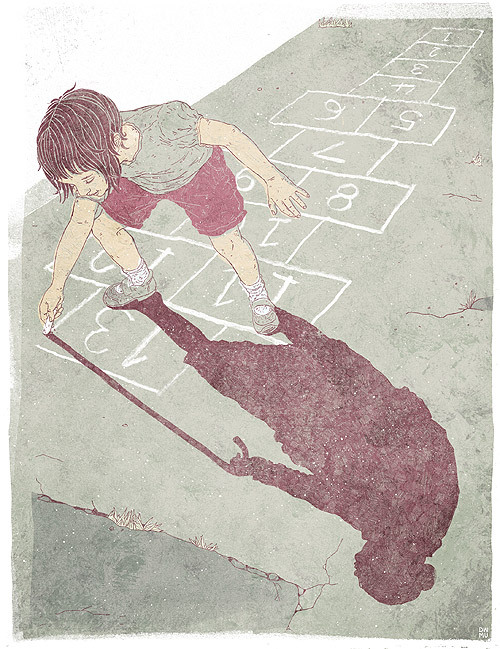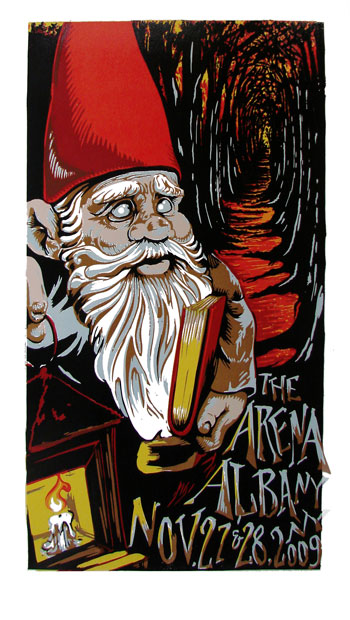by Jonathan Edwards.
I was definitely looking forward to this lecture, if there's one thing I love about Creative Futures, it's when graduates who have been in our exact shoes (so to speak obviously!) and to see that they've broken into the creative industry successfully and are still achieving new highs. Jonathan Edwards is a brilliant example of this.
Jonathan told his story in two parts, he started off with editorial and comic book work before investing in his
Inspector Cumulus character that he accidently creating when flicking through his sketchbook. Jonathan said that he always had an interest in vinyl and collectable toys, and that is the direction that he saw his character going in. It just goes to show that you should trust your instinct, you know your creation just like you should know how much is too much, you should also know how far to push it.
Jonathan touched on the issue that i'm currently having, the fact that we just sit around waiting to be asked to do something, I feel like someone is going to come along and
ask me to do a commission etc whereas it should be me going out and making myself known. And that is what he did, he took his character to
Play Lounge, a company that aims to represent the latest innovative toys that aren't necessarily restricted to child play. From there he was connected to
Crazy Label another company dedicated to toy manufacturing. Jonathan had a very hands on approach to the production of his toy, having constant feedback with the manufacturers, referring to his original design and concept and even designing the packaging too. This is something that is particularly inspirational, how he was dedicated to creating a toy that reflected his original idea and not become distorted when it easily could.
In both parts of his story, social networking had a huge part to play in the success of his work. For
Inspector Cumulus toy, the popular blog
ToysREvil caught on to it and created a buzz around the character. Jonathan advised that we should use
Twitter in order to get our name know whilst still in Uni, so that come graduation you've already got a head start. Now this is something I wholeheartedly agree with, and do try to put into practice however that send button because awfully daunting when you're sending something to, maybe not the most famous illustrator, but someone you admire. It's something I'll have to get over, and hopefully will with confidence!
Second part of the story- Alongside his partner Louise Evans AKA
Felt Mistress, he has produced window displays for Londons best retailers including Selfridges and boutiques. They play to each others strengths, Jonathan comes up with the character designs then Louise (magically) turns them into felt toys. He described their experience with working with Selfridges, being featured instore and the window displays. They seem a very hard working pair! I was amazed to see that
all of their characters connect in some way, a sign of a well thought out and detailed concept.
They also got intouch with a Japanese agency in order to take part in a residency in which they would create characters, something that played to the cultural differences of toys being a much more popular market in Japan as opposed to here in the UK. This again showed that you shouldn't be afraid to approach people with work, especially if you feel passionate about what it is you do.
The thing I like most about Jonathan (and Louise) is that he stays loyal
to his style. During some of the talks this week, you can see how the
illustrator has changed their original concept so much in order to
satisfy the client or designer, whereas Jonathan, even when dealing with
big named clients, stuck by the way that he saw his character in order
to create the best possible outcome. That is definitely something that we as emerging creatives should remember; stick to your guns!
So, the parting advice, was that you should
draw inspiration from wherever possible. Jonathan told us that he draws inspiration from things around him; people observing in cafes, shapes, real people (sometimes well known).It's something that I like the idea of but never seem to getting round to it or never have my sketchbook to hand, maybe i'll try to better myself during the summer. But the inspiration part has changed the way I look at things, I try not to close myself off to things, always listening to what people are seeing and if it can be used in some way, drawing and making a note of things that inspire me or ideas that I have so that I can revisit them in someway and some point.
He shared that he was once told that you either draw realisitically, with proportions etc or you draw using shapes, and the more I think about it, the more it makes sense. He said that for him it was a lightbulb moment and he suddenly realised that he had been doing it wrong the whole time, then turned his focus to shapes. I feel like he's triggered my own lightbulb moment, hopefully, so we'll see how it goes!
You have to get through the bad in order to improve, so the next time i'm sketching something and it looks awful, i'll finish it before I cry! This is something that I need to realise, I expect everything to look perfect the first time I do it, which is obviously not going to happen but I should learn from it and do it better the next time.
Keep a sketchbook,
set yourself goals,
connect through social networks. For me, it just shows that if you find something unique, have good ideas and execute them well, abit of self promotion and you'll go far!
This talk also made me think about collaborations, its obviously had a positive effect on both parties work, one compliments the other and it goes to show that if you find the rightwork that influences/compliments yours then it can be beneficial. It's something i'll consider in the future.
A thoroughly enjoyable lecture, and dare I say, the best one yet (who cares if its only Tuesday!).
All images belong to Jonathan Edwards - www.jonathan-e.com/
































